
Herman Saftleven the Younger (1609 - 5 January 1685 (buried)), was a Dutch painter of the Baroque period.

Herman Saftleven the Younger (1609 - 5 January 1685 (buried)), was a Dutch painter of the Baroque period.
Born in Rotterdam, Saftleven lived most of his life (1632–1685) in Utrecht. His brothers, Cornelis Saftleven (1607–1681) and Abraham Saftleven were both painters. The former was even better known as a painter, specializing in genre scenes, while Herman was known for his landscapes of river scenes as well as of persons traveling through woods. His father, Herman Saftleven I was a painter in Rotterdam, who died by 1627. One of Herman II’s daughters, Sara Saftleven, born in Utrecht after 1633, also became a painter of flowers in watercolors. She married Jacob Adriaensz Broers in 1671.
Herman became the dean of the Guild of St Luke in Utrecht. After a storm had destroyed most of the town in the 1670s, he sold the city a series drawings he had made of Utrecht churches before they were destroyed. In the 1680s, he was commissioned by the amateur botanist and horticulturalist Agnes Block, to draw flowers and plants at her country estate near Utrecht. He died in Utrecht.
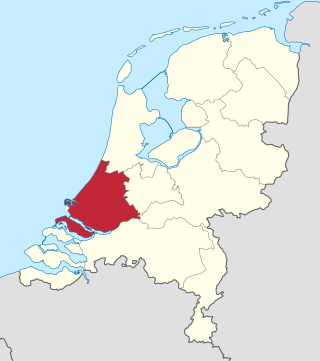
South Holland is a province of the Netherlands with a population of over 3.7 million as of October 2021 and a population density of about 1,373/km2 (3,560/sq mi), making it the country's most populous province and one of the world's most densely populated areas. Situated on the North Sea in the west of the Netherlands, South Holland covers an area of 3,307 km2 (1,277 sq mi), of which 607 km2 (234 sq mi) is water. It borders North Holland to the north, Utrecht and Gelderland to the east, and North Brabant and Zeeland to the south. The provincial capital is the Dutch seat of government The Hague, while its largest city is Rotterdam. The Rhine-Meuse-Scheldt delta drains through South Holland into the North Sea. Europe's busiest seaport, the Port of Rotterdam, is located in South Holland.
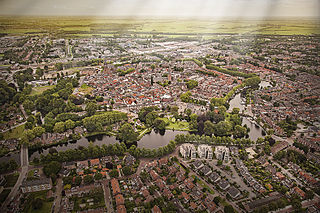
Woerden is a city and a municipality in central Netherlands. Due to its central location between Amsterdam, Rotterdam, The Hague, and Utrecht, and the fact that it has rail and road connections to those cities, it is a popular town for commuters who work in those cities.

Abraham Bloemaert was a Dutch painter and printmaker who used etching and engraving. He initially worked in the style of the "Haarlem Mannerists", but by the beginning of the 17th-century altered his style in line with the new Baroque style that was then developing. He mostly painted history subjects and some landscapes. He was an important teacher, who trained most of the Utrecht Caravaggisti.

Willem Marinus Dudok was a Dutch modernist architect. He was born in Amsterdam. He became City Architect for the town of Hilversum in 1928 where he was best known for the brick Hilversum Town Hall, completed in 1931. Not only did he design the building, but also the interior including the carpets, furniture and even the mayor's meeting hammer. He also designed and built about 75 houses, public buildings and entire neighborhoods.

Hendrick Jansz ter Brugghen was a Dutch painter of genre scenes and religious subjects. He was one of the Dutch followers of Caravaggio – the so-called Utrecht Caravaggisti. Along with Gerrit van Hondhorst and Dirck van Baburen, Ter Brugghen was one of the most important Dutch painters to have been influenced by Caravaggio.
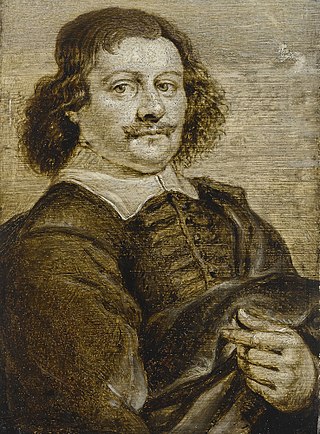
Jan Dirksz Both was a Dutch painter, draughtsman, and etcher, who made an important contribution to the development of Dutch Italianate landscape painting.

Roelant Savery was a Flanders-born Dutch Golden Age painter.

Adriaen van Utrecht was a Flemish painter known mainly for his sumptuous banquet still lifes, game and fruit still lifes, fruit garlands, market and kitchen scenes and depictions of live poultry in farmyards. His paintings, especially the hunting and game pieces, show the influence of Frans Snyders. The two artists are considered the main inventors of the genre of the pronkstillevens, i.e. still lifes that emphasized abundance by depicting a diversity of objects, fruits, flowers and dead game, often together with living people and animals. Van Utrecht also painted a number of flower still lifes. He was a regular collaborator with leading Antwerp painters who had been pupils or assistants of Peter Paul Rubens, such as Jacob Jordaens, David Teniers the Younger, Erasmus Quellinus II, Gerard Seghers, Theodoor Rombouts, Abraham van Diepenbeeck and Thomas Willeboirts Bosschaert.

Cornelis Saftleven was a Dutch painter who worked in a great variety of genres. Known in particular for his rural genre scenes, his range of subjects was very wide and included portraits, farmhouse interiors, rural and beach scenes, landscapes with cattle, history paintings, scenes of Hell, allegories, satires and illustrations of proverbs.

Simon de Vos was a Flemish painter, draughtsman and art collector. He started his career making small-format cabinet pictures of genre scenes, in particular of Caravaggesque merry companies. Later he switched to history painting, working on larger formats in a Flemish Baroque style which was influenced by Rubens and van Dyck.

Flemish Baroque painting was a style of painting in the Southern Netherlands during Spanish control in the 16th and 17th centuries. The period roughly begins when the Dutch Republic was split from the Habsburg Spain regions to the south with the Spanish recapturing of Antwerp in 1585 and goes until about 1700, when Spanish Habsburg authority ended with the death of King Charles II. Antwerp, home to the prominent artists Peter Paul Rubens, Anthony van Dyck, and Jacob Jordaens, was the artistic nexus, while other notable cities include Brussels and Ghent.

Abraham Danielsz. Hondius was a Dutch Golden Age painter known for his depictions of animals. He was the son of a city stonemason, Daniel Abramsz de Hondt.
Dirck van der Lisse was a Dutch Golden Age painter.
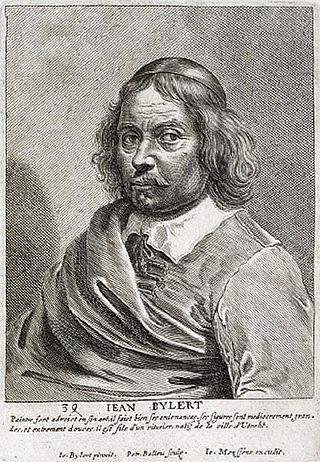
Jan Hermansz van Bijlert was a Dutch Golden Age painter from Utrecht, one of the Utrecht Caravaggisti whose style was influenced by Caravaggio. He spent some four years in Italy and was one of the founders of the Bentvueghels circle of northern painters in Rome.

Willem van Bemmel, or Guillaume, or Wilhelm von Bemmel, was a Dutch Golden Age landscape painter who moved to Germany.
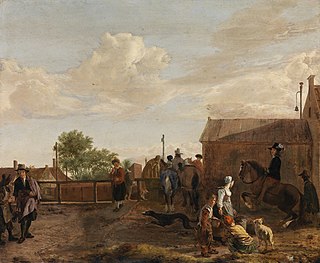
Ludolf de Jongh or Ludolf Leendertsz. de Jongh was a Dutch painter, known for his genre scenes, hunting scenes, history paintings, landscapes, cityscapes and portraits. He was further a merchant, an officer in the civil guard of Rotterdam and a schout (sheriff) of Hillegersberg. He was in the 1650s the leading genre painter in Rotterdam whose work influenced artists such as Pieter de Hooch. He was active as a staffage painter and added the figures in the works of artists such as the church interior painter Anthonie de Lorme and the landscape painter Joris van der Haagen.
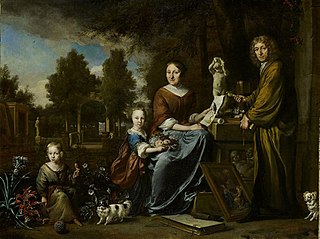
Agnes, or Agneta Block was a Dutch art collector and horticulturalist. She is most remembered as the compiler of an album of flower and insect paintings.

The Utrecht Guild of Saint Luke refers to two artist collectives in Utrecht (city); the old Catholic Zadelaarsgilde dating from the Middle Ages, as well as the newer Sint Lucas Gilde established in 1611. The first collective was for a number of trades that were connected to the art industry, though the smiths had their own guild called the "St. Eloyen" guild. The second collective was founded for the oil painters after the Protestant Reformation. The Zadelaarsgilde fell under the patron saint Luke the Evangelist and the St. Eloyen guild fell under Saint Eligius.
Johannes Vorstermans, was a Dutch Golden Age landscape painter. Considered superior to all of his contemporaries, he created works for Charles II. The Scottish artist, T. Graham referred to him as F. de Vosterman.
Sara Saftleven, was a Dutch Golden Age flower painter.
![]() Media related to Herman Saftleven at Wikimedia Commons
Media related to Herman Saftleven at Wikimedia Commons